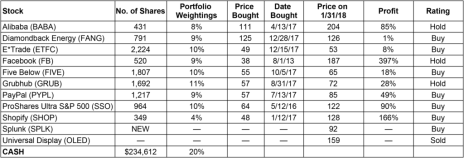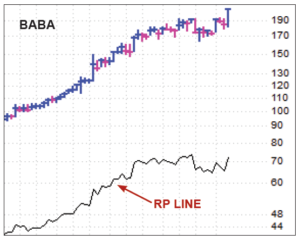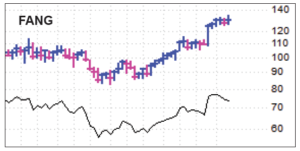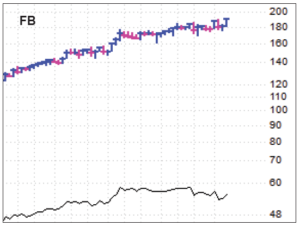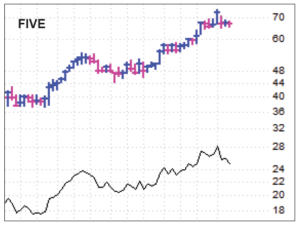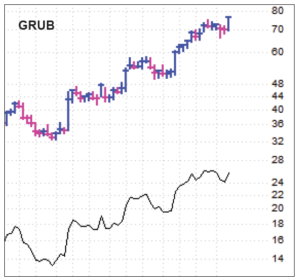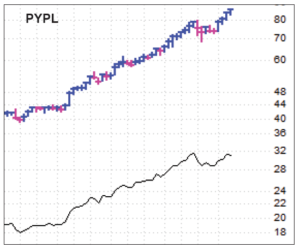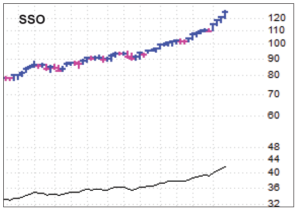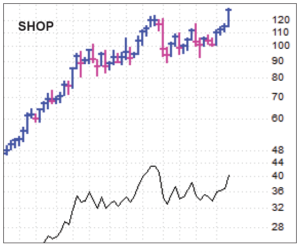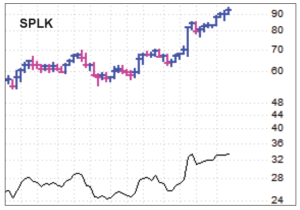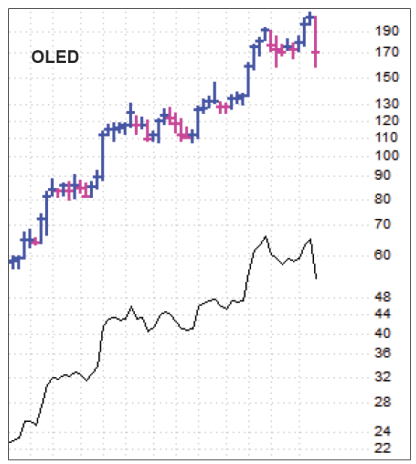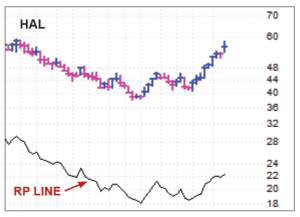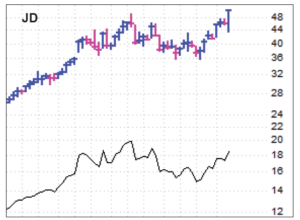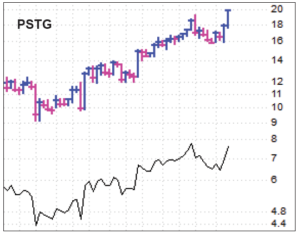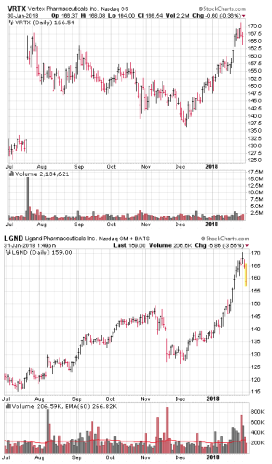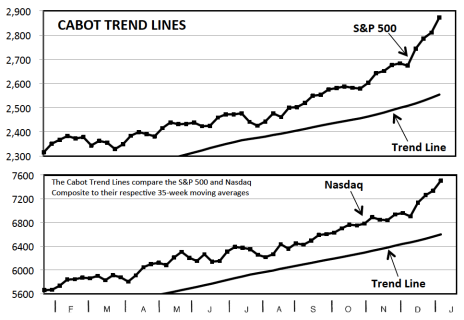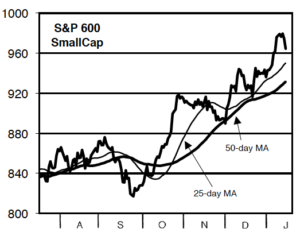After a huge run, the market finally hit some turbulence this week, and it’s a 50-50 bet whether we see more profit taking going forward. Our focus is mostly on the bigger picture (still very bullish) and individual stocks, as the advance has gotten more selective and earnings season is revving up. We remain mostly bullish, but it remains important to take things on a stock-by-stock basis.
Cabot Growth Investor 1386
[premium_html_toc post_id="143917"]
Bullish But More Selective
From a top-down perspective, we don’t have much new to add to what we’ve been writing for the past few weeks. Sure, the major indexes have finally taken a blow this week, but that wasn’t unexpected given their recent runs. At last week’s close, the S&P 500 was 12.5% above its 35-week moving average, the widest spread in nearly five years!
In the short-term, it’s a coin flip whether this year’s uptrend continues or whether we see further retrenchment in the days and weeks ahead. So instead of playing that guessing game, our focus remains on the market’s longer-term outlook and the action of individual growth stocks.
On the longer-term front, we already did a deep dive in the last issue about the many blastoff indicators that have flashed. And here’s another: The S&P 500 finished up more than 5% for the month of January. That’s only happened 12 times since 1950—on average, the S&P gained another 17.3% by year-end (and that includes the 1987 crash)!
Thus, while we’re keeping an eye open for red flags (our Two-Second Indicator is one, as new lows have surged with the recent rise in interest rates), the odds still favor 2018 being a bullish year.
It’s on the individual stock side that we’re seeing some changes—the advance has become more selective, with more stocks and sectors hitting potholes for one reason or another. You can see this in the chart of the IBD 85-85 Index, which is trending higher but underperforming the major indexes.
As earnings season revs up (most stocks we watch or own will report within the next couple of weeks), the goal is to rotate out of any older, tired stocks that crack and move into fresher, more vibrant growth names that are providing good entry points. With that in mind, we kicked out two stocks from the Model Portfolio this month, but tonight, we’re adding a new stock we’ve been watching for a few weeks.
[highlight_box]WHAT TO DO NOW: Remain mostly bullish, but stay flexible as earnings season continues. In the Model Portfolio, we pulled the plug on our remaining shares of Universal Display (OLED) last week, which left us with 20% in cash. Tonight, we’re putting about half of that back to work by purchasing Splunk (SPLK). Details below.[/highlight_box]
Model Portfolio Update
After a smooth run for the major indexes in 2017 and a month-long moonshot in January, the sellers have finally put up a fight. Of course, many pundits are giving reasons for the weakness (U.S. dollar, interest rates, etc.), but to us, it’s simply the fact that most stocks and indexes are extended and sentiment has been very bubbly for a while—two of the factors that prompted us to hold the cash from two sales this month.
That said, you shouldn’t change your game plan because of a couple of bad days. It’s still a bull market! With our positions, we’re taking things on a stock-by-stock basis—some look just fine, some are coming under pressure and most report earnings during the next three weeks. As for new buying, we’re still being choosy, but we’re seeing some opportunities show up during this pullback.
Last week, we sold Universal Display (OLED), leaving us with around 20% in cash. That’s a bit high for our tastes, and with a little steam having come out of the market, we’re going to add Splunk (SPLK) to the Model Portfolio tonight, leaving us with about 10% on the sideline.
Current Recommendations
HOLD—Alibaba (BABA 204)—BABA surged to new highs last week on excellent volume; the RP line is still shy of its old highs, but even so, the action is definitely positive. That said, the real test is coming tomorrow morning (February 1), when the company releases fourth-quarter results—analysts see earnings rising 28%, though because the company usually tops expectations, the outlook, details about some newer businesses (like cloud computing) and user growth will be just as important. If the stock can get through the report in good shape, the odds will favor the stock’s longer-term uptrend resuming. But given that earnings are right around the corner, we’ll officially stay on Hold here and see what comes.
BUY—Diamondback Energy (FANG 126)—FANG slipped this week as oil prices pulled back after a healthy run, and shares also got hit after Permian peer Parsley Energy (PE) collapsed on earnings—the drop was from fears of large drilling expenses as prices of equipment and fracking rise with demand. We think that news is pretty superficial though, as cost inflation is a fact of life during strong drilling environments and is outweighed by the rise in energy prices. The bottom line is that analysts see Diamondback’s earnings rising 35% this year, and that probably doesn’t take into account much of oil’s recent advance. A drop back into the mid-110s would tell us that the recent multi-year breakout has failed, but right here, we’re thinking FANG is a good buy.
BUY—E*Trade Financial (ETFC 53)—E*Trade reported a fine fourth quarter last week. Revenues rose a solid 24%, driven by a big 45% gain in net interest income, though non-interest revenue was basically flat due to the early-2017 commission cut. (Total trading activity rose 26% in Q4 from a year earlier, while commission per trade dipped 29%.) The other sub-metrics—total customer assets up 23%, margin balances up 28%—all looked good, driving earnings up 52%. Analysts bumped up their earnings estimates in response (+38% this year, +14% in 2019). The stock has dropped off a couple of points, but the uptrend is intact. A drop back into the upper 40s would be a yellow flag, but we’re staying on Buy, thinking dips will eventually give way to higher prices.
HOLD—Facebook (FB 157)—FB hasn’t kept up with the market so far this year, but it has hit a couple of higher highs, and we’re encouraged by the stock’s quick snapback from the News Feed selloff two weeks ago. Like many other stocks, though, FB’s intermediate-term future will probably be determined by the quarterly report, which is due out tonight—analysts are looking for a 43% gain in revenue and earnings of $1.95 per share, but any commentary surrounding the News Feed changes and outlook on this year’s spending expectations (always a big deal at Facebook) could move the stock. For our part, we’re sticking with the same plan—a big-volume drop into the mid- to upper 160s (below the long-term 200-day line) could have us taking the rest of our big profit and moving on. But until then, we’re holding patiently, and any show of strength could have us moving back to Buy. We’ll let you know if we have any changes post-report.
BUY—Five Below (FIVE 65)—FIVE’s action this year has been suspicious, at least short-term—the stock took a big hit earlier this month and hasn’t done much even as the market lifted. That said, selling pressure has been light, the longer-term trend is up and the fundamental story is as good as any retail stock out there (analysts see earnings up 29% this year and another 20% next). We could move to Hold if the stock continues to struggle, and a dip into the upper-50s might have us selling to protect what’s left of our profit. Right now, though, we’re sticking with a Buy rating, thinking FIVE’s overall uptrend (remember, it just broke out from a multi-year base in October) is likely to resume. Earnings are likely out near the end of February.
HOLD—Grubhub (GRUB 72)—GRUB is a good example of the kind of choppy, volatile action we’ve been seeing among many growth stocks. The stock dipped to its 50-day line earlier this month, but found solid support and surged to new highs within a couple of weeks—before a downgrade (partly based on valuation, partly based on competitive risks) on Tuesday knocked the stock back into its consolidation. We still have high hopes for GRUB; if you don’t own any and want to nibble, we’re fine with that. But officially, we’ll stay on Hold and see how the stock reacts to earnings (February 8) and yesterday’s downgrade.
BUY—PayPal (PYPL 85)—PYPL dipped with everything else earlier this week, but volume was light and shares snapped back to new highs today. The market was the main culprit behind the hiccup, though some sellers appeared after it was reported that Softbank, the giant Japanese internet company, was going to build its own international payments system, competing with PayPal and others. We don’t really view that as much to worry about, given PayPal’s established business (more than 200 million accounts!) and new products (like Venmo) that are catching on fast. We’re far more interested in the quarterly report, which is due out tonight (January 31)—analysts see revenues up 22% and earnings up 24%. We’ll stay on Buy but will be watching to see how the report is received.
BUY—ProShares Ultra S&P 500 Fund (SSO 122)—SSO suffered its worst down day in many months on Tuesday, and in the short-term, it wouldn’t be surprising to see some further weakness—the fund is still about 10 points above its 50-day line! Because of that, we could take partial profits if we see more signs that a meaningful correction and consolidation is underway. However, we’re not going there yet, as the S&P 500 is just a couple of days off its peak and our market timing indicators and many longer-term studies tell us the bull market has farther to run. We’ll be watching to see if the selling pressures intensify, but until then, we’ll stay on Buy and advise buying on dips of a couple of points.
BUY—Shopify (SHOP 128)—SHOP has wobbled this week, but it hasn’t altered the growing evidence that the stock became sold out in late December and is now turning up, with the stock nosing to new price peaks before last Friday. Fundamentally, we think Shopify is a leader in a major trend that doesn’t get much publicity—helping out small- and mid-sized businesses, most of which have been passed over by lenders (because of risk aversion) and service providers (looking for big, safer dollars by selling to larger outfits) in recent years. But with the global economy accelerating and lots of small business benefits in the recent tax bill (full expensing, 20% tax cut), we think this “sector” could see a spending boom, which would benefit Shopify. Of course, like most stocks, a lot will come down to earnings, which are due on February 15—a collapse back into the upper 90s would be bearish, but right now, the odds favor a new upmove is getting underway. You can buy a small position here if you’re not yet in.
BUY—Splunk (SPLK 92)—We’ve been watching Splunk closely since its gapped up on earnings in November, which looks like the kickoff to a major new advance after years of base-building. Story-wise, the company remains the King of Big Data, offering the industry’s best and increasingly popular software to help companies (and, increasingly, the government, which is becoming a bigger customer) improve productivity and security by better understanding their mountains of machine data. Analysts expect sales and earnings to grow at nearly 50% rates this year and next, with cash flow doing the same. It’s not a perfect entry point, but we think SPLK is buyable here, with plenty of support in the low- to mid-80s. We’re adding a 10% position to the Model Portfolio tonight.
SOLD—Universal Display (OLED 159)—Things can change in a hurry when it comes to the market, and that was certainly the case with OLED, which was looking fine a couple of weeks ago but then fell off a cliff, supposedly because of iPhone X worries. Whatever the reason, the action looks abnormal, with the stock staging its biggest down week and heaviest weekly volume in more than three years. We write more about our sale of OLED (“Selling Early or Selling Late”) later in this issue, but suffice it to say that we took the rest of our profit and see better opportunities elsewhere.
Watch List
Canada Goose (GOOS 36): Goose continues to act very well and has many of the same characteristics as successful high-end retailers of years past. There’s no set date yet for earnings.
Ligand Pharmaceuticals (LGND 158): It’s a bit thinly traded, but LGND has an excellent, high-margin story and a newly-powerful chart. See details later in this issue.
Vertex Pharmaceuticals (VRTX 167): Vertex’s cystic fibrosis franchise is driving solid growth, and the firm has a few label expansions and combination therapies that could be approved this year. Earnings are due out after the close today. See more in our write-up on biotech stocks.
Other Stocks of Interest
The stocks below may not be followed in Cabot Growth Investor on a regular basis. They’re intended to present you with ideas for additional investment beyond the Model Portfolio. For our current ratings on these stocks, see Updates on Other Stocks of Interest on the subscriber website or email mike@cabotwealth.com.
Halliburton (HAL 54) — With $21 billion in annual revenue, Halliburton is one of the top oil-field services companies in the world, which makes it a bit big for our kind of growth investing. But despite its size, HAL has a history of making big runs, including one from 11 in December 2008 to 53 in July 2011. After a correction and rebase, HAL rallied from 28 in November 2012 to 70 in July 2014. And during 2016, the stock popped from 27 in January to 49 at year-end. So now, with the strong price of oil stoking oil-field activity and the company booking revenue growth of over 42% in the last two quarters, HAL might be ready for another of its mega-rallies. Like many companies in the oil patch, Halliburton cut costs during the long depression in oil prices, and $65-a-barrel oil may be the catalyst needed to kick HAL into high gear again. Analysts see earnings more than doubling this year.
JD.com (JD 49) —JD.com is China’s largest online retailer and biggest retailer overall, with a market cap of nearly $70 billion and $49 billion a year in revenue. JD.com is every bit as ambitious as Alibaba and (unlike Alibaba) actually owns, warehouses and delivers its own inventory. Despite seven years of revenue growth in excess of 34%, the company’s build-out of its fulfillment infrastructure kept a lid on earnings until the middle of 2016. Earnings growth has been 850% (Q1), 43% (Q2) and 360% in Q3 2017. JD made a great run from the start of 2017 to the middle of May, but hacked around for the rest of the year before pushing to new all-time highs in January. With alliances with Baidu, investments in Vipshop Holdings and investments from Tencent Holdings and Walmart, JD.com has a very bright future.
Pure Storage (PSTG 20) — The name says it all. Pure Storage provides safe, secure storage, not for household goods, but for corporate data. The company’s flash-based platform enables easy access to (and simple management of) data from any mobile device. Pure Storage is relatively young—incorporated in 2009 and came public in 2015—and its stock chart shows one big cup formation. After a three-month rally from 9 in March 2017, PSTG made a high at 19 in November, then trailed back to 16 in December and January. The stock’s rally from a gap up on January 17 to over 20 in recent trading, seems to be in response to a price target increase from a Barclays analyst. Revenue growth has accelerated over the past three quarters, notching 41% in Q3. It’s a good story.
Wayfair (W 92) — Wayfair, for anyone who hasn’t seen the company’s energetic TV ads, is an online furniture, furnishings and home accessories company that’s growing revenue year-by-year, but hasn’t booked any profits yet. But those revenue gains—from $1.32 billion in 2014 to $3.38 billion in 2016 and an estimated $4.64 billion last year—are pretty persuasive. Wayfair has been undercut by fears about competition and has survived a short-selling attack to trace an 11-week rally from 56 in November to a new high at 95 this week. The company will report its Q4 results on February 22 before the open and analysts are looking for $1.36 billion in revenue and a loss of 53 cents per share. It looks like W is under persistent accumulation, and a buy on a normal pullback could pay off.
Biotechs: For Real this Time?
Biotechs were the leading growth sector in the market from 2012 through mid-2015, with the S&P Biotech Fund (XBI) rising 264% in just three and a half years. (We favor using the XBI over the iShares Biotech Fund (IBB) because it’s far less dependent on the sector’s mega-cap stocks.)
Then came the collapse, with XBI falling 52% to its low in early 2016. And while that was the bottom, the recovery during 2016 and 2017 was very choppy and featured a ton of false starts—there were four 14%-plus corrections just in the first year of XBI’s recovery, and even during the smooth 2017 uptrend, the fund saw retreats of 9%, 10%, and 12%.
This year, though, XBI has lifted to new all-time highs (breaking free from a three-month base), and if earnings season goes well, we think the odds are high that the sector has finally entered a more sustainable uptrend.
Of course, biotechs are always known for big moves by speculative, no-revenue development stage firms. But we prefer real sales and earnings growth, and the leading big- and mid-cap biotech leaders have historically done well when the sector gets going.
Right now, our two favorites are Vertex Pharmaceuticals (VRTX) on the big-cap side of things, and Ligand Pharmaceuticals (LGND) for mid-caps.
Vertex is best known for its cystic fibrosis (CF) drugs, two of which make up the vast majority of all revenue, and the company is set to greatly expand its target CF market via label expansions, European approval for one of its treatments and the likely approval of a new combination therapy this year. Analysts see revenues and earnings up 18% and 60% this year, but more will be known after the quarterly report and conference call tonight (January 31). The stock is near the top of a six-month consolidation.
Ligand has one of the more unique stories out there. The firm conducts early research, discovers potential drugs and has a couple of powerful research platforms, then it partners with other companies that design (and pay for) clinical trials and/or license those research platforms. If a drug hits the market, Ligand is in line for royalties and milestone payments. It’s a low-cost business, and while two drugs make up the majority of royalties today, more and more drugs are likely to hit the market in the years ahead. Analysts see revenue and earnings up 20% and 44% this year, with much more upside beyond that. The stock took a hit today after a negative article online, but this comes after a steady, good-volume advance that easily took shares to new highs.
Bottom line, the evidence suggests that the group has changed character—and the two-and-a-half year crash and recovery process has separated the wheat from the chaff. VRTX and LGND are our two favorites and are on our Watch List; either one could be added to the Model Portfolio.
Sell Early or Sell Late
Many subscribers have asked about our decision to sell Universal Display last week, questioning why we were so late to pull the trigger. Our answer: When it comes to selling winners, you’re either going to sell early (on the way up) or late (after the top, on the way down).
We prefer to sell late (at least for most of our shares; we often take partial profits on the way up) to try to capture a longer-term trend—which is where the real money is made. However, what goes along with that strategy and mindset is the crummy feeling of watching your stock plunge for a few days and break support before you exit.
If there were a way to consistently sell just a day or two after the top, we would, but realistically, that’s not possible. And, importantly, if you’re too sensitive to down days or weeks, your chances of developing a big winner are minimized.
Just look at Universal’s action of the past year—OLED suffered an 18% drop from June through late-August (which included an initial 14%, two-day plunge!), a 14% drop over just four days in September, and then an 18%, seven-day pothole after Thanksgiving! If you were using a super-tight stop, you would have been knocked out a long time ago.
When the stock began to fall last week, it wasn’t totally out of character, but we pulled the plug when it tripped our stop around 170. Our point, though, is that selling after a good-sized drop is part of the ballgame in riding longer-term winners—yes, the drawdowns are never fun, but without being open to taking some heat, it’s hard to make big money.
Cabot Market Timing Indicators
As earnings season has gotten underway, we’ve seen the market’s stellar advance thin out a bit, with many stocks and sectors starting to hesitate (or worse). That could be a prelude to a shorter-term retreat, but with the trends of most indexes and leading stocks positive, we remain heavily invested.
Cabot Trend Lines: Bullish
With the major indexes kiting higher, our Cabot Trend Lines remain clearly positive—in fact, both the S&P 500 (by 12.5%) and Nasdaq (by 13.7%) are as far above their 35-week moving averages as they have been in years. Shorter-term, that means the market is at risk of a pullback, but longer-term, such a rally (along with other unusual signs of strength we wrote about in the last issue) means the odds favor even higher prices ahead.
Cabot Tides: Bullish
Our Cabot Tides are also still bullish, with all five of the indexes we track (including the S&P 600 SmallCap, shown here) handily above their lower (50-day) moving averages. Digging deeper, small-cap stocks have been lagging their larger-cap brethren, which goes along with the narrowing of the rally we’ve seen lately. But that doesn’t change the fact that the intermediate-term remains firmly up.
Two-Second Indicator: Unhealthy
Our Two-Second Indicator has once again had the rug pulled out from under it, as the number of new lows has expanded in a big way, mostly due to interest rate-sensitive securities hitting the skids. It’s a worry, and could be the first indication of a thinning broad market advance that leads to problems down the road. But we’re putting more emphasis on the action of the major indexes and leading stocks, which remain positive.
[premium_html_footer]
Send questions or comments to mike@cabotwealth.com.
Cabot Growth Investor • 176 North Street, Post Office Box 2049, Salem, MA 01970 • www.cabotwealth.com
All Cabot Growth Investor’s buy and sell recommendations are made in issues or updates and posted on the Cabot subscribers’ website. Sell recommendations may also be sent to subscribers as special bulletins via email and the recorded telephone hotline. To calculate the performance of the portfolio, Cabot “buys” and “sells” at the midpoint of the high and low prices of the stock on the day following the recommendation. Cabot’s policy is to sell any stock that shows a loss of 20% in a bull market (15% in a bear market) from our original buy price, calculated using the current closing (not intra-day) price. Subscribers should apply loss limits based on their own personal purchase prices.
Charts show both the stock’s recent trading history and its relative performance (RP) line, which shows you how the stock is performing relative to the S&P 500, a broad-based index. In the ideal case, the stock and its RP line advance in unison. Both tools are key in determining whether to hold or sell.
THE NEXT CABOT GROWTH INVESTOR WILL BE PUBLISHED FEBRUARY 14, 2018
We appreciate your feedback on this issue. Follow the link below to complete our subscriber satisfaction survey: Go to: www.surveymonkey.com/marketlettersurvey
Neither Cabot Wealth Network nor our employees are compensated by the companies we recommend. Sources of information are believed to be reliable, but are in no way guaranteed to be complete or without error. Recommendations, opinions or suggestions are given with the understanding that subscribers acting on the information assume all risks. © Cabot Wealth Network. Copying and/or electronic transmission of this report is a violation of U.S. copyright law. For the protection of our subscribers, if copyright laws are violated, the subscription will be terminated. To subscribe or for information on our privacy policy, call 978-745-5532, visit www.cabotwealth.com or write to support@cabotwealth.com.
[/premium_html_footer]


